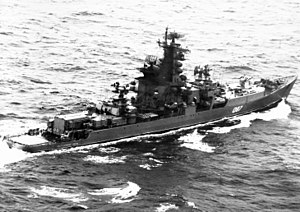This article includes a list of references, related reading, or external links, but its sources remain unclear because it lacks inline citations. (January 2013) |
 Vitse-Admiral Drozd in 1986
| |
| Class overview | |
|---|---|
| Name | Kresta I class |
| Builders | Zhdanov Shipyard, Leningrad |
| Operators | |
| Preceded by | Kynda class |
| Succeeded by | Kresta II class |
| Built | 1964–1967 |
| In commission | 1967–1994 |
| Planned | 35 |
| Completed | 4 |
| Cancelled | 31 |
| Retired | 4 |
| General characteristics | |
| Type | Cruiser |
| Displacement |
|
| Length | 159 m (521 ft 8 in) |
| Beam | 17 m (55 ft 9 in) |
| Draught | 6 m (19 ft 8 in) |
| Propulsion |
|
| Speed | 34 knots (63 km/h; 39 mph) |
| Range | 10,500 nautical miles (19,400 km; 12,100 mi) at 14 knots (26 km/h; 16 mph) |
| Complement | 343-360 |
| Sensors and processing systems |
|
| Armament |
|
| Aircraft carried | 1 × Ka-25 series helicopter |
| Aviation facilities | Helipad and hangar |
The Kresta I class, Soviet designation Project 1134 Berkut (golden eagle), was a class of guided missile cruiser built in the Soviet Union for the Soviet Navy. The ships were designed for a surface warfare role, but Soviet priorities were changed to an anti-submarine role and only four ships were built in this configuration. They were followed by the Kresta II class, an anti-submarine warfare variant.